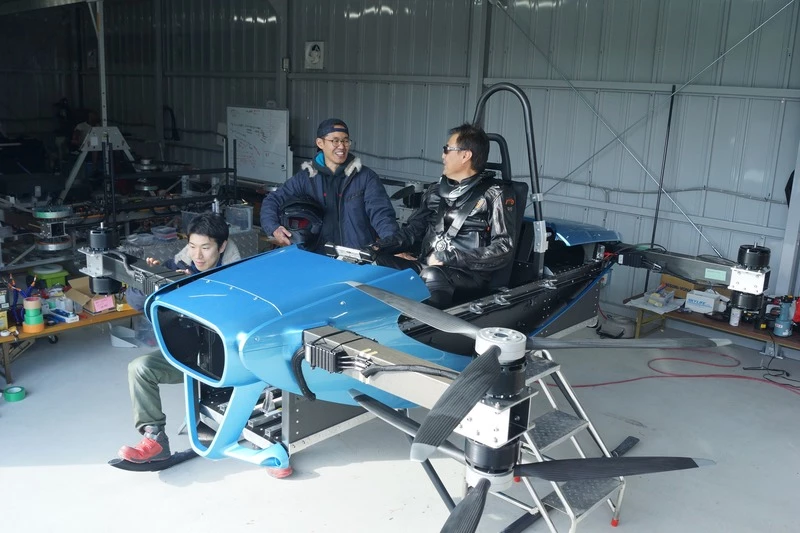Japan's fledgeling eVTOL sector appears to be led by a company called Cartivator, started as a side project by a group of Toyota employees and indeed funded by Toyota to the tune of 40 million yen, or US$354,000. The group was responsible for NEC's wobbly air taxi concept last year, and its spinoff SkyDrive has now released a photo of what it claims is Japan's first manned multirotor test flight.
Cartivator's aircraft are about as simple as they come; the NEC concept was a simple big-prop quadcopter with a cabin dangling underneath, and the SkyDrive prototype they've just flown is an 8-rotor coaxial multirotor with a small, boxy cabin on top and some clear plastic shields between the pilot and the props. No fiddly, high efficiency flight mode transitioning for these guys, they're just going to plonk you in a big version of a Phantom drone.
This has not deterred investors, who put a very handy US$14 million into SkyDrive in an investment round last year, giving the company a very lean budget in the scheme of eVTOL development, but a good starting point to prove their mettle.
While straight-up multirotors might not offer much in the way of range or flight efficiency, let's not forget: Japan is pushing hard for a hydrogen economy, and hydrogen-powered multirotors may well not need to worry about range, since the high energy density of liquid hydrogen makes fuel cell-powered multirotors an immediate commercial possibility, while batteries still have several leaps to go before they're viable. SkyDrive isn't saying anything about hydrogen right now, but the ability to deliver long range flights and super-quick refueling would be no small advantage, and Japan would be an ideal place to start playing with hydrogen.
Manned flight tests began in December last year and continued until March, at which point the SkyDrive team was happy to pronounce its "technical verification" phase complete, with the "controllability and flight stability" of the test aircraft "confirmed." The pilot's feedback is now being consolidated into another round of design and prototyping.

Under the technical guidance of new CTO Nobuo Kishi, an aerospace engineer "who has held top posts at Mitsubishi Aircraft Corporation," SkyDrive is aiming to launch its eVTOL product into the Japanese market by 2023. It's unclear exactly what that product will be – an aircraft, or a service? Either way, there's a battle ahead to get the thing through aviation certification and solve the safety challenges that face most multirotor designs when you start putting people in them. Mr. Kishi has plenty of prior experience with type certification, so he'll be aware of the rocky road ahead.
One safety solution SkyDrive has been working on with the Cartivator team is a pilot seat mounted on a crumple-capable column of shock-absorbing metal inspired by the impact-absorbing design on a popular Japanese running shoe. The "Mizuno Wave" system can do a certain amount to limit the lumbar spine shock of a direct vertical drop, but one wonders just how high up it'll be useful.

We might have greater confidence in SkyDrive if it showed itself capable of producing high-res photos instead of the heavily pixellated shots on the company website.
Source: SkyDrive via evtol.news





